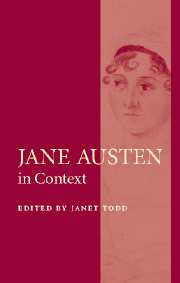26 - Literary Scene
Published online by Cambridge University Press: 19 December 2020
Summary
In 1800 a now forgotten novelist, Robert Bisset, identified the three leading practitioners of his craft: ‘Were I to characterize Mrs. Ratcliffe, Mrs. Smith, and Miss Burney by one prominent feature in their works I should say that Mrs. Ratcliffe was chiefly distinguished by vivacity of fancy, Mrs. Smith by tenderness of feeling, Miss Burney by acuteness, force, and comprehensiveness of understanding.’ Jane Austen would surely have agreed with his ranking. By 1800 she had already drafted three of her novels. Northanger Abbey affectionately burlesqued the Radcliffe manner, Austen's father identified the genealogy of ‘First Impressions’ as it was then titled, by describing it to the publisher Thomas Cadell as ‘about the length of Miss Burney's Evelina’ and when it was finally published its title, Pride and Prejudice, was taken from Burney's Cecilia, and the future Lady Byron confidently reported after reading it that it had been written by ‘a sister of Charlotte Smith’s’. When Henry Tilney acknowledges that he has read ‘all of Mrs. Radcliffe's works, and most of them with great pleasure’ (NA, 1:14), he underlines his good sense, and one of Austen's earlier heroines, ‘Catharine’, tests the ability of a new acquaintance by engaging her in a discussion about the novels of Charlotte Smith, but for Austen, as for the forgotten Robert Bisset, it was Frances Burney who took the palm. It was one of two ‘pleasing’ traits in the character of a Miss Fletcher that ‘she admires Camilla’ (L, 15–16 September 1796), and Jane Austen's niece Caroline records that the only occasion on which she can remember her aunt reading aloud she had taken up ‘a volume of Evelina and read a few pages of Mr Smith and the Brangtons and [Caroline] thought it was like a play’ (Le Faye, Family Record, p. 183). It was from Burney that Austen inherited the main lineaments of the plot that was to serve her throughout her career, the misadventures of a young woman at what she, like Sir Thomas Bertram, seems to have judged ‘the most interesting stage’ of her life, that is, the time during which she makes her choice of marriage partner (MP, 1:3).
- Type
- Chapter
- Information
- Jane Austen in Context , pp. 289 - 296Publisher: Cambridge University PressPrint publication year: 2005
- 3
- Cited by



